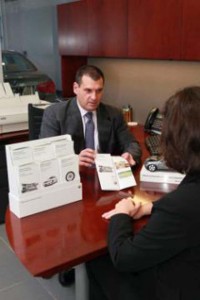BMW is betting on a new, high-tech marketing system to build both sales and owner loyalty rates.
The new program is designed to increase contact between the company and its customers – and to convince them to trade in their current BMW products sooner and more often, explains Shaun Bugbee, vice president of sales and marketing for the German maker’s American captive finance subsidiary.
Currently, about 55% of the customers who borrow money through BMW Financial pay off their loans ahead of schedule – typically at around 33 months on a 60-month contract, notes Bugbee. A key reason is that BMW has, for the last several years, been offering heavily subvented, or subsidized, loans, often with interest rates of just 0.9% or 1.9%. That makes it easy to pay down equity in a hurry.
But the automaker has come to realize that when customers pay off their loans early they are more likely to trade in—often on a competing brand. Retail owner loyalty rates, Bugbee says, have been running just 20%. But a pilot program tested in BMW 12 dealerships has bumped that by as much as 12 percentage points. So, it is now being rolled out nationwide.
“It will look for people who are in an equity position after 18 months” from buying a new car financed by BMW Financial, the executive says. And, if they have a good payment history, they will be contacted about possibly trading in early for a new car or sport-activity vehicle that could be purchased at about the same monthly rate. “It’s a good conversation starter,” Bugbee suggests, noting the pilot program yielded a significant bump in sales and loyalty.
Currently, about 45% of BMW’s U.S. customers lease their vehicles, while 32% purchase their vehicles outright using BMW Financial. Another 23% either pay cash or finance using an outside lender, Bugbee says.
It’s a competitive market, and the low-interest programs have helped the captive finance subsidiary pick up business, especially during the financial meltdown, when many banks and other financial institutions were pulling back on automotive lending.
BMW is rethinking how heavily it needs to subsidize buyers, especially as the American luxury car market begins to revive. And Bugbee says he is, “starting to see movement upwards” in loan rates. Going forward, “Your FICO score (credit rating) will determine what rate you get. The higher your score the lower you get” in terms of interest rates.
The automaker is also looking at how much to emphasize leasing, a popular form of low-cost financing that took some big hits during the last two years of financial meltdown. In the middle of the last decade as many as six in 10 BMW vehicles were leased in the U.S. market. That is currently down in the mid-40% range, but Bugbee said the maker will try to push that back up to somewhere short of 50%.
One reason is that leasing provides a steady and predictable supply of used vehicles that feed BMW’s popular certified pre-owned program. In recent years, used vehicle volumes have nearly matched new. But while the maker’s dealers will take back 143,000 off-lease BMWs in 2010, that is expected to fall to just 94,000 next year. It is, says Bugbee, “an Achilles Heel” for a company that has put so much emphasis on its certified pre-owned, or CPO, effort.
That is another reason why BMW is now reaching out to retail customers who might be convinced to trade in early. This would not only help boost sales of new cars – but provide an increased flow of used BMWs to prop up the CPO program.

